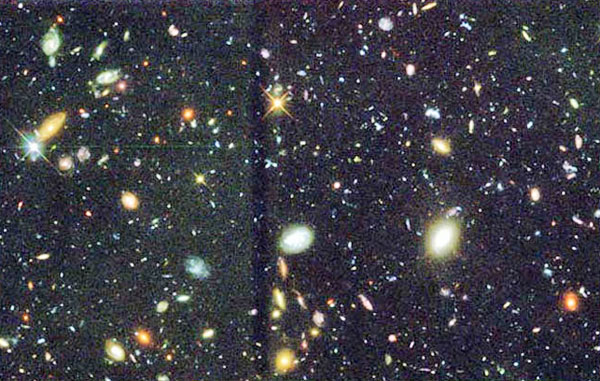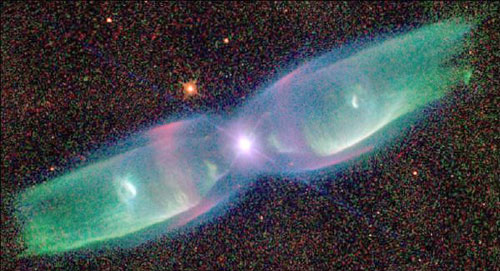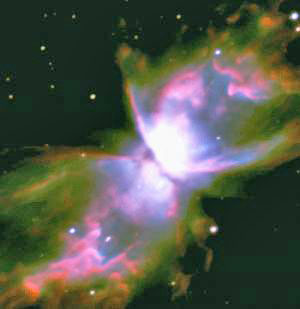|
|
|
by David Talbott December 27, 2004 from Thunderbolts Website
Credit: HDF Team/NASA
You'd never know it
from official news releases, but the Big Bang is broken and can't be
fixed.
The Big Bang has lost its theoretical foundation, which was the Doppler interpretation of redshift (linking redshift to the stretching of light wavelengths as objects move away from us).
It is now known that, while almost all observed galaxies are redshifted, the Doppler interpretation of this shift does not provide a reliable measure of velocity or (indirectly) of distance.
Quasars and galaxies of different redshift stand in physical proximity to each other and are observed to be connected by filaments of matter.
Quasars, whose high
redshift would place them at the outer edges of the
visible universe, are in fact physically and energetically linked to
nearby low-redshift active galaxies.
Over decades, Arp amassed meticulous observations challenging the standard use of redshift to prove an expanding universe. But astronomers ignored or dismissed Arp's work, insisting that his conclusions were either erroneous or impossible.
Arp lost his teaching
position. Then he lost his telescope time and had to move to Germany
to carry on his work at the Max Planck Institute.
To his credit, Cornell astronomer Carl Sagan acknowledged the problem when he was writing Cosmos (published in 1980).
But in the following years the politically
influential looked the other way, and the word quietly went out to
science editors at major newspaper and news magazines that Arp
had been fully answered and no more time was needed on the question.
The effect is called "the fingers of God,"
and the earth-directed "fingers" span billions of light-years.
Theorists should have stopped to
notice the obvious.
No domain of scientific inquiry stands in isolation. It is now known that intense electric discharge (such as coronal mass ejections from the Sun) can generate a redshift having no connection to relative velocities.
But cosmologists developed their ideas about redshift and the Big Bang under the assumption of an electrically inert universe.
Their theoretical starting point invariably shaped their thinking about the birth of galaxies. And these ideas, in turn, conditioned scientific reasoning as to how a galaxy's constituent stars came into existence. Concepts of star formation further constrained scientific reasoning about planetary origins and the evolution of life.
From the core of intertwined assumptions, the chains of logic
reached out to inspire - but also to shackle - human exploration.
Though much of today's exercises in esoteric mathematics came after publication of Sagan's Cosmos, America's favorite astronomer in the 1980's had registered a timely warning:
Over the past quarter century the pure mathematicians, with little or no interest in experimental science and only a passing regard for direct observation, have indulged in a carnival of speculation.
But it is mind altering to realize that almost nothing revealed by our more powerful telescopes was anticipated by these theorists. We now observe a superabundance of fine filaments across vast reaches of space. In the electrically neutral cosmos claimed by gravity-based cosmology, these filaments find no credible cause.
But in plasma experiments with electric discharge, they are predictable.
Nobel laureate Hannes Alfvén, the father of plasma physics, showed that cosmologists are mistaken when they imagine that magnetic fields can be "frozen in" to a plasma.
Electric currents are required to sustain cosmic magnetic fields. And now, everywhere we look we see magnetic fields at work: electricity is flowing across immense distances in space.
At both the stellar and galactic scales, these currents interact with the magnetic fields they induce to create complex structure - strings of galaxies, galactic and stellar jets, and beautiful bipolar stellar nebulas - all with features never envisioned by gravitational theorists, yet corresponding in stunning detail to plasma discharge formations in the laboratory.
Bipolar Planetary Nebula M2-9
The bipolar Butterfly Nebula NGC 6302
Will the year 2005 see a new beginning for cosmology?
When you consider the sheer momentum of earlier theory, together with the potential costs in terms of reputations, public funding, and threatened jobs, it would be foolish to expect the "tipping point" to mean a wholesale abandonment of the Big Bang in one year.
Discredited theories rarely meet either an instantaneous or a quiet death.
But we can
confidently predict a year of rapidly growing controversy, on an
issue whose final outcome is indeed certain.
|





